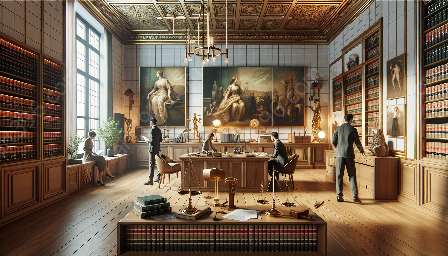The historical development of the First Amendment and the concept of artistic freedom is an intriguing journey that intersects with art, law, and the protection of individual rights. Exploring this rich history provides insight into the evolving understanding of expressive freedom and its relationship with artistic creativity.
Understanding the First Amendment and Its Origins
The First Amendment of the United States Constitution, ratified in 1791 as part of the Bill of Rights, ensures various fundamental freedoms, including freedom of speech, press, assembly, and the right to petition the government. However, the protection of these liberties has roots that extend far back into history.
The First Amendment's origins trace back to England's long struggle for free expression and the limitations imposed by the monarchy. The historical context of English common law and landmark documents such as the Magna Carta and the Petition of Right in 1628 laid the groundwork for the principles later enshrined in the First Amendment. It reflects a deep-seated belief in the necessity of safeguarding individuals' freedom to express themselves without fear of censorship or retaliation.
The Intersection of First Amendment Rights and Artistic Freedom
Artistic expression has often been at the center of First Amendment debates. From visual arts and literature to music and performance, artists have pushed the boundaries of creative freedom while testing the limits of societal acceptance and government intervention. Historically, artists have grappled with censorship, moral outrage, and legal challenges as they sought to convey their perspectives and ideas through their work.
Artistic freedom intertwines with the First Amendment's protection of speech and expression, as the courts have consistently recognized the profound impact of art on public discourse and individual autonomy. Landmark cases, such as Miller v. California and Tinker v. Des Moines Independent Community School District, have contributed to defining the legal parameters and exceptions regarding artistic expression within the framework of the First Amendment.
Art Law and the Protection of Artistic Freedom
The field of art law delves into the intricate relationship between legal doctrines and the creation, dissemination, and interpretation of art. Art law encompasses a wide range of issues, including intellectual property rights, contracts, provenance, cultural heritage, and censorship challenges. It provides a crucial framework for understanding how legal principles intersect with the preservation and promotion of artistic freedom.
Grounded in constitutional protections and statutory provisions, art law plays a vital role in shaping the dynamics of artistic expression and commerce. It addresses the complexities arising from copyright and trademark laws, the ethical considerations of cultural appropriation, and the tensions between artistic freedom and public interests. This multidisciplinary field reflects the evolving landscape of art and its entanglement with legal norms and societal values.
Conclusion
Exploring the historical foundations of the First Amendment and artistic freedom illuminates the enduring struggle to balance individual liberties with societal interests and moral standards. The interconnectedness of art, First Amendment rights, and art law underscores the profound impact of creative expression on the fabric of democratic societies. As the legal landscape continues to evolve, understanding the historical context and foundational principles remains indispensable for advocating and safeguarding artistic freedom in a rapidly changing world.

